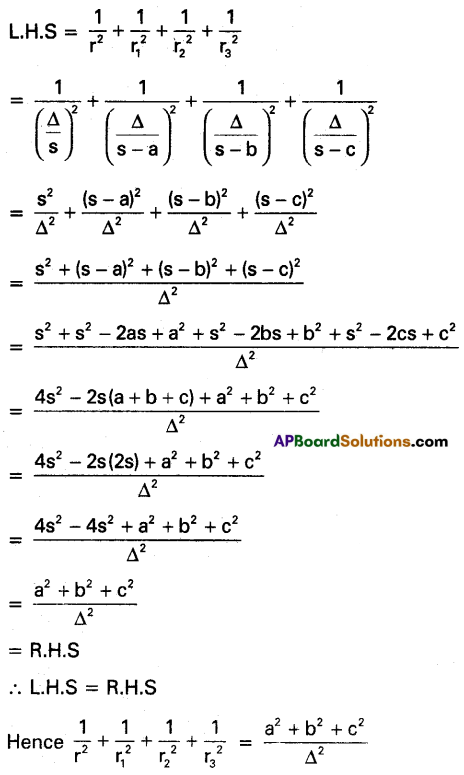Thoroughly analyzing TS Inter 1st Year Maths 1A Model Papers and TS Inter 1st Year Maths 1A Question Paper March 2017 helps students identify their strengths and weaknesses.
TS Inter 1st Year Maths 1A Question Paper March 2017
Time: 3 Hours
Maximum Marks: 75
Note: This question paper consists of three Sections A, B, and C.
Section – A
(10 × 2 = 20 Marks)
I. Very Short Answer Type Questions
- Answer all questions.
- Each question carries two marks.
Question 1.
If A = \(\left\{0, \frac{\pi}{6}, \frac{\pi}{4}, \frac{\pi}{3}, \frac{\pi}{2}\right\}\) and f: A → B is surjection defined by f(x) = cos x then find B.
Solution:
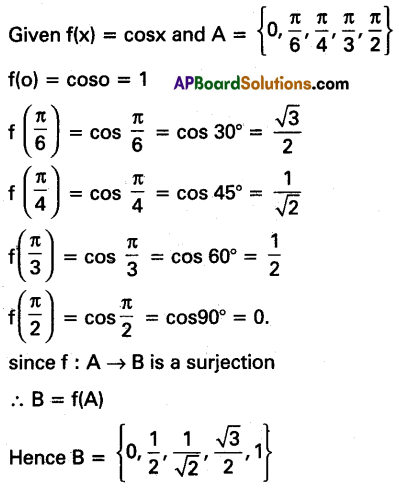
Question 2.
If f(x) = 2, g(x) = x2, h(x) = 2x for all x ∈ R, then find (fo(goh))(x).
Solution:
Given f(x) = 2, g(x) = x2 and h(x) = 2x
[fo(goh)] (x) = f[(goh)(x)]
= f[g{h(x)}]
= f[g(2x)]
= f[(2x)2]
= f(4x2)
= 2
Hence [fo(goh)] (x) = 2
![]()
Question 3.
If A = \(\left[\begin{array}{ccc}
3 & 2 & -1 \\
2 & -2 & 0 \\
1 & 3 & 1
\end{array}\right]\), B = \(\left[\begin{array}{ccc}
-3 & -1 & 0 \\
2 & 1 & 3 \\
4 & -1 & 2
\end{array}\right]\) and X = A + B then find X.
Solution:

Question 4.
If A = \(\left[\begin{array}{rr}
-1 & 2 \\
0 & 1
\end{array}\right]\) then find AA’.
Solution:
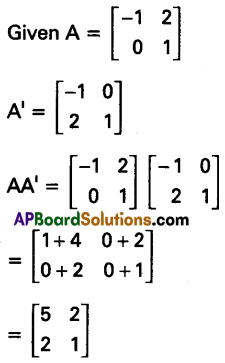
Question 5.
a = 2i + 5j + k and b = 4i + mj + nk are collinear vectors then find m and n.
Solution:
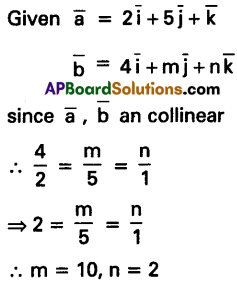
Question 6.
Find the vector equation of the line passing through the point \(2 \bar{i}+3 \bar{j}+\bar{k}\) and parallel to the vector \(4 \overline{\mathrm{i}}-2 \overline{\mathrm{j}}+3 \overline{\mathrm{k}}\).
Solution:
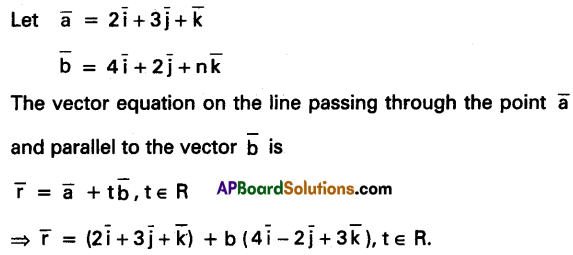
Question 7.
Find the angle between the vectors i + 2j + 3k and 3i – j + 2k.
Solution:
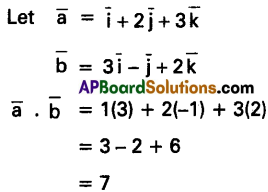

Question 8.
If sin θ = \(\frac{4}{5}\) and θ is not in the first quadrant, find the value of cos θ.
Solution:
Given sin θ = \(\frac{4}{5}\), θ is not in the first quadrant.
sin θ = \(\frac{4}{5}\) > 0
∴ ‘θ’ lies in second quadrant.
cos2θ = 1 – sin2θ
= 1 – \(\left(\frac{4}{5}\right)^2\)
= 1 – \(\frac{16}{25}\)
= \(\frac{9}{25}\)
∴ cos θ = ±\(\frac{3}{5}\)
since ‘θ’ lies in the second quadrant.
∴ cos θ = \(\frac{3}{5}\)
![]()
Question 9.
Prove that cos 48° . cos 12° = \(\frac{3+\sqrt{5}}{8}\).
Solution:
L.H.S = cos 48° . cos12°
= \(\frac{1}{2}\) [2 cos 48° . cos 12°]
= \(\frac{1}{2}\) [cos (48° + 12°) + cos (48° – 12°)]
= \(\frac{1}{2}\) [cos 60° + cos 36°]
= \(\frac{1}{2}\left[\frac{1}{2}+\frac{\sqrt{5}+1}{4}\right]\)
= \(\frac{1}{2}\left[\frac{2+\sqrt{5}+1}{4}\right]\)
= \(\frac{3+\sqrt{5}}{8}\)
= R.H.S
∴ L.H.S = R.H.S
Hence cos 48° . cos 12° = \(\frac{3+\sqrt{5}}{8}\)
Question 10.
If cosh x = \(\frac{5}{2}\), find the values of (i) cosh (2x) and (ii) sinh (2x).
Solution:

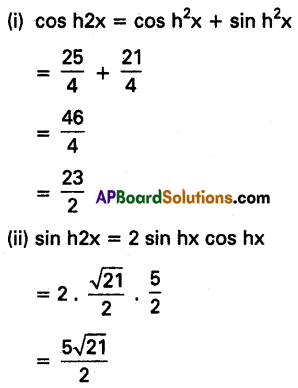
Section – B
(5 × 4 = 20 Marks)
II. Short Answer Type Questions
- Attempt any five questions.
- Each question carries four marks.
Question 11.
Show that \(\left|\begin{array}{lll}
1 & a & a^2 \\
1 & b & b^2 \\
1 & c & c^2
\end{array}\right|\) = (a – b) (b – c) (c – a).
Solution:

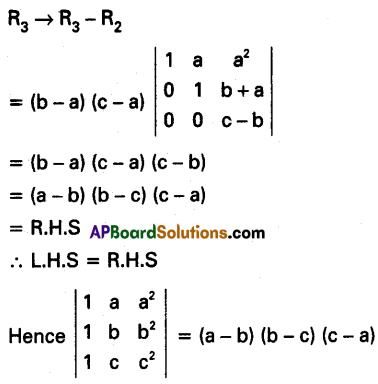
Question 12.
If a, b, c are non-coplanar find the points of intersection of the line passing through the points 2a + 3b – c, 3a + 4b – 2c with the line joint the points a – 2b + 3c, a – 6b + 6c.
Solution:
The vector equation of the line passing through the points
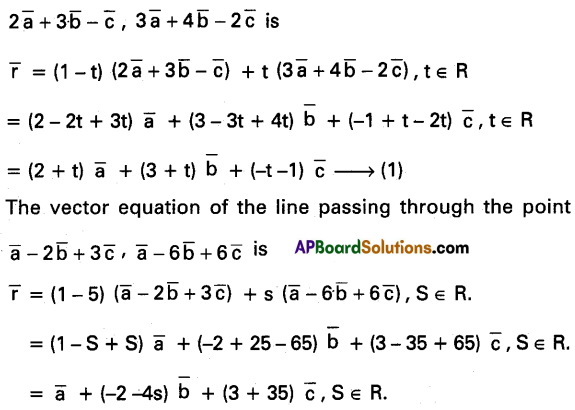
If (1) and (2) intersect then
2 + t = 1 ⇒ t = -1
3 + t = -2 – 4s
⇒ 3 + (-1) = -2 – 4s
⇒ 2 = -2 – 4s
⇒ 4 = -4s
⇒ s = -1
∴ t = -1, s = -1
∴ point of intersection of (1) and (2) is
\(\bar{r}\) = [2 + (-1)] \(\bar{a}\) + [3 + (-1)] \(\bar{b}\) + [-(-1) – 1] \(\bar{c}\)
= (2 – 1) \(\bar{a}\) + (3 – 1) \(\bar{b}\) + (1 – 1) \(\bar{c}\)
= \(\bar{a}\) + 2\(\bar{b}\)
![]()
Question 13.
If a = 2i + j – k, b = -i + 2j – 4k and c = i + j + k then find (a × b) . (b × c).
Solution:

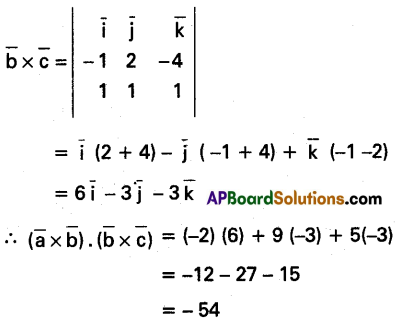
Question 14.
(i) Find the range of 13 cos x + 3√3 sin x – 4.
Solution:
Given function 13 cos x + 3√3 sin x – 4
Here a = 13, b = 3√3 and c = -4
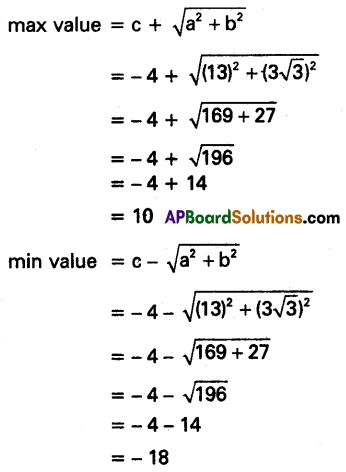
∴ Range = [-18, 10]
(ii) Evaluate \(\sin ^2 82 \frac{1}{2}^{\circ}-\sin ^2 22 \frac{1}{2}^{\circ}\).
Solution:
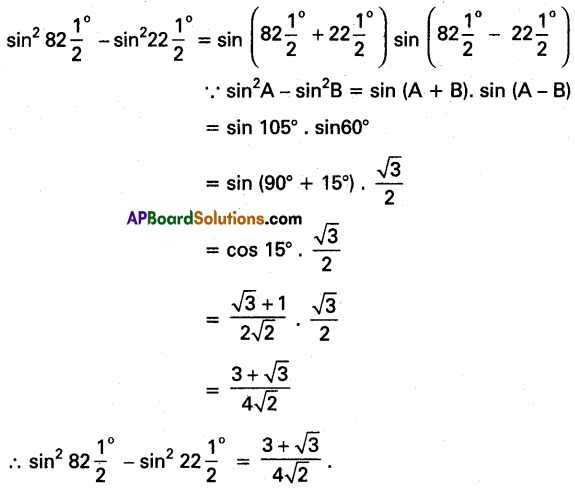
Question 15.
Solve 1 + sin2θ = 3 sin θ . cos θ.
Solution:
Given 1 + sin2θ = 3 sin θ cos θ
⇒ \(\frac{1}{\cos ^2 \theta}+\frac{\sin ^2 \theta}{\cos ^2 \theta}=\frac{3 \sin \theta \cos \theta}{\cos ^2 \theta}\)
⇒ sec2θ + tan2θ = 3 tan θ
⇒ 1 + tan2θ + tan2θ = 3 tan θ
⇒ 2 tan2θ – 3 tan θ + 1 = 0
⇒ 2 tan2θ – 2 tan θ – tan θ + 1 = 0
⇒ 2 tan θ (tan θ – 1) – 1(tan θ – 1) = 0
⇒ (tan θ – 1) (2 tan θ – 1) = 0
⇒ tan θ – 1 = 0 (or) 2 tan θ – 1 = 0
∴ tan θ = 1
⇒ tan θ = tan \(\frac{\pi}{4}\)
⇒ θ = nπ + \(\frac{\pi}{4}\), n ∈ z
∴ 2 tan θ = 1
⇒ tan θ = \(\frac{1}{2}\)
⇒ tan θ = tan α
where α is principal value of tan θ = \(\frac{1}{2}\)
∴ θ = nπ + α, n ∈ z.
∴solution set X = {nπ +\(\frac{\pi}{4}\)/n ∈ z} ∪ {nπ + α/n ∈ z}
Question 16.
Show that \(\cot \left(\sin ^{-1} \sqrt{\frac{13}{17}}\right)=\sin \left(\tan ^{-1} \frac{2}{3}\right)\).
Solution:
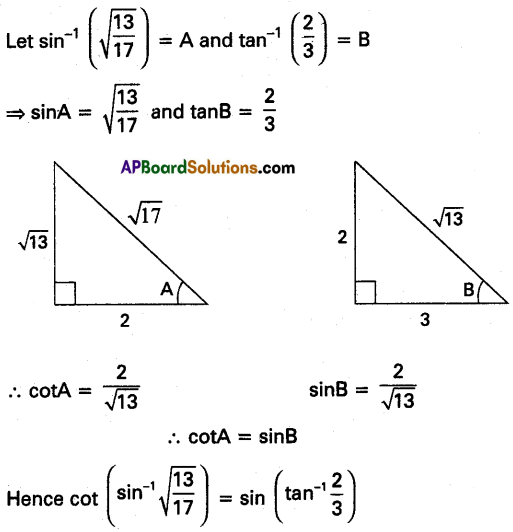
Question 17.
In ΔABC, if \(\frac{1}{a+c}+\frac{1}{b+c}=\frac{3}{a+b+c}\), show that C = 60°.
Solution:
Given \(\frac{1}{a+c}+\frac{1}{b+c}=\frac{3}{a+b+c}\)
⇒ \(\frac{1}{a+c}+\frac{1}{b+c}-\frac{3}{a+b+c}\) = 0
⇒ \(\frac{(b+c)(a+b+c)+(a+c)(a+b+c)-3(a+c)(b+c)}{(a+c)(b+c)(a+b+c)}\) = 0
⇒ (b + c) (a + b + c) + (a + c) (a + b + c) – 3(a + c) (b + c) = 0
⇒ (b + c + a + c) (a + b + c) – 3(a + c) (b + c) = 0
⇒ (a + b + 2c) (a + b + c) – 3(ab + ac + bc + c2) = 0
⇒ a2 + ab + ac + ba + b2 + bc + 2ac + 2bc + 2c2 – 3ab – 3ac – 3bc – 3c2 = 0
⇒ a2 + b2 – c2 – ab = 0
⇒ 2ab cos c = ab {∵ By cosine rule c2 = a2 + b2 – 2ab cos c}
⇒ cos c = \(\frac{1}{2}\)
⇒ cos c = cos 60°
⇒ c = 60°
Section – C
(5 × 7 = 35 Marks)
III. Long Answer Type Questions
- Attempt any five questions.
- Each question carries seven marks.
Question 18.
(i) If f: Q → Q is defined by f(x) = 5x + 4, ∀ x ∈ Q, show that f is a bijection and find f-1.
Solution:
Given f: Q → Q is defined by f(x) = 5x + 4 ∀ x ∈ Q.
Let x1, x2 ∈ Q and f(x1) = f(x2)
⇒ 5x1 + 4 = 5x2 + 4
⇒ 5x1 = 5x2
⇒ x1 = x2
∴ f is one-one.
Let y ∈ Q (codomain) then there exists x = \(\frac{y-4}{5}\)
such that f(x) = f(\(\frac{y-4}{5}\))
= 5(\(\frac{y-4}{5}\)) + 4
= y – 4 + 4
= y
∴ f is onto
∴ f is one-one and onto
∴ f is a bijection.
∴ f-1; Q → Q is also a bijection.
Let f(x) = y
⇒ 5x + 4 = y
⇒ 5x = y – 4
⇒ x = \(\frac{y-4}{5}\)
⇒ f-1(y) = \(\frac{y-4}{5}\)
⇒ f-1(x) = \(\frac{x-4}{5}\)
(ii) If f = {(4, 5), (5, 6), (6, -4)} and g = {(4, -4), (6, 5), (8, 5)} then find f + g and fg.
Solution:
Given f = {(4, 5), (5, 6), (6, -4)}
g = {(4, -4), (6, 5), (8, 5)}
∴ Domain of f is A = {4, 5, 6}
Domain of g is B = {4, 6, 8}
Domain of f + g is A ∩ B = {4, 6}
∴ f + g = {(4, 5 – 4), (6, -4 + 5)} = {(4, 1), (6, 1)}
Domain of fg is A ∩ B = {4, 6}
∴ fg = {(4, (5)(-4), (6, (-4)(5)} = {(4, -20), (6, -20)}
![]()
Question 19.
Using mathematical induction, prove 1 . 2. 3 + 2 . 3 . 4 + 3 . 4 . 5 + …… upto n terms = \(\frac{n(n+1)(n+2)(n+3)}{4}\), ∀ n ∈ N.
Solution:
1, 2, 3 …… are in A.P.
nth term = 1 + (n – 1) 1 = n
2, 3, 4 ……… are in A.P.
nth term = 2 + (n – 1) 1 = n + 1
3, 4, 5 ……… are in A.P.
nth term = 3 + (n – 1) 1 = n + 2
∴ nth term of the series = n (n + 1) (n + 2)
Let S(n) be the statement that
1.2.3 + 2.3.4 + 3.4.5 +……. + n(n+1)(n+2) = \(\frac{n(n+1)(n+2)(n+3)}{4}\)
If n = 1 then L.H.S. = 1.2.3 = 6
RHS = \(\frac{1(1+1)(1+2)(1+3)}{4}\) = 6
∴ L.H.S. = R.H.S.
∴ S(1) is true.
Assume that S(k) is true.
1.2.3 +2.3.4 + 3.4.5+ ……. + k(k+1) (k+2) = \(\frac{k(k+1)(k+2)(k+3)}{4}\)
Adding (k + 1) (k + 2) (k + 3) on both sides, we have
1.2.3 + 2.3.4 +…..+ k(k + 1) (k + 2) + (k + 1) (k + 2) (k + 3)
= \(\frac{k(k+1)(k+2)(k+3)}{4}\) + (k + 1)(k + 2)(k + 3)
= \(\frac{k(k+1)(k+2)(k+3)+4(k+1)(k+2)(k+3)}{4}\)
= \(\frac{(k+1)(k+2)(k+3)(k+4)}{4}\)
∴ S(k + 1) is true.
∴ By the principle of finite mathematical induction S(n) is true for all n ∈ N.
Question 20.
Solve the following system of equations by using Cramer’s rule:
2x – y + 3z = 9
x + y + z = 6
x – y + z = 2
Solution:
Given system of equations are
2x – y + 3z = 9
x + y + z = 6
x – y + z = 2
The given system of equations can be expressed as AX = B
where A = \(\left[\begin{array}{ccc}
2 & -1 & 3 \\
1 & 1 & 1 \\
1 & -1 & 1
\end{array}\right]\), X = \(\left[\begin{array}{l}
x \\
y \\
z
\end{array}\right]\) and B = \(\left[\begin{array}{l}
9 \\
6 \\
2
\end{array}\right]\)
Δ = \(\left[\begin{array}{ccc}
2 & -1 & 3 \\
1 & 1 & 1 \\
1 & -1 & 1
\end{array}\right]\)
= 2(1 + 1) – (-1) (1 – 1) + 3(-1 – 1)
= 2(2) + 1(0) + 3(-2)
= 4 – 6
= -2
Δ1 = \(\left[\begin{array}{ccc}
9 & -1 & 3 \\
6 & 1 & 1 \\
2 & -1 & 1
\end{array}\right]\)
= 9(1 + 1) + 1(6 – 2) + 3(-6 – 2)
= 18 + 4 – 24
= -2
Δ2 = \(\left[\begin{array}{lll}
2 & 9 & 3 \\
1 & 6 & 1 \\
1 & 2 & 1
\end{array}\right]\)
= 2(6 – 2) – 9(1 – 1) + 3(2 – 6)
= 8 – 0 – 12
= -4
Δ3 = \(\left[\begin{array}{ccc}
2 & -1 & 9 \\
1 & 1 & 6 \\
1 & -1 & 2
\end{array}\right]\)
= 2(2 + 6) + 1(2 – 6) + 9(-1 – 1)
= 16 – 4 – 18
= -6
x = \(\frac{\Delta_1}{\Delta}=\frac{-2}{-2}\) = 1
y = \(\frac{\Delta_2}{\Delta}=\frac{-4}{-2}\) = 2
z = \(\frac{\Delta_3}{\Delta}=\frac{-6}{-2}\) = 3
∴ x = 1, y = 2, z = 3
Question 21.
(i) Show that A = \(\left[\begin{array}{lll}
1 & 2 & 1 \\
3 & 2 & 3 \\
1 & 1 & 2
\end{array}\right]\) is non-singular and find A-1.
Solution:
Given A = \(\left[\begin{array}{lll}
1 & 2 & 1 \\
3 & 2 & 3 \\
1 & 1 & 2
\end{array}\right]\)
|A| = \(\left[\begin{array}{lll}
1 & 2 & 1 \\
3 & 2 & 3 \\
1 & 1 & 2
\end{array}\right]\)
= 1(4 – 3) – 2(6 – 3) + 1(3 – 2)
= 1 – 6 + 1
= -4 ≠ 0
∴ A in non-singular.
∴ A-1 exists.
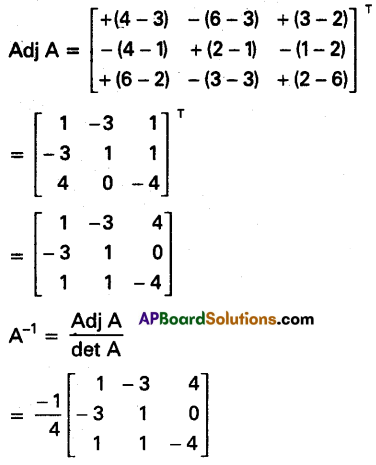
(ii) If A = \(\left[\begin{array}{lll}
1 & 2 & 2 \\
2 & 1 & 2 \\
2 & 2 & 1
\end{array}\right]\) then show that A2 – 4A – 5I = 0.
Solution:


Question 22.
Find the shortest distance between the skew lines r = (6i + 2j + 2k) + t(i – 2j + 2k) and r = (-4i – k) + s(3i – 2j – 2k).
Solution:
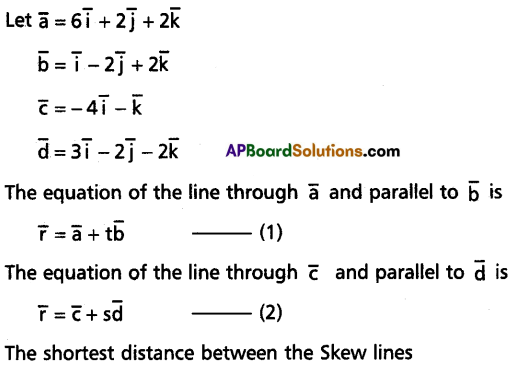
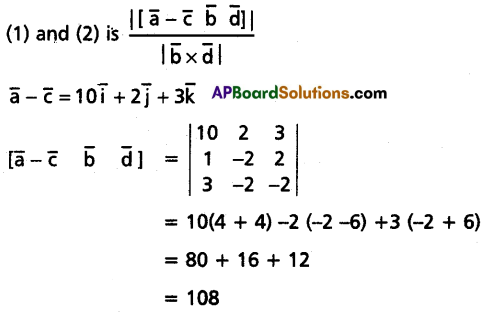

![]()
Question 23.
If A + B + C = 2S, then prove that cos (S – A) + cos (S – B) + cos C = -1 + 4 cos \(\frac{S-A}{2}\) cos \(\frac{S-B}{2}\) cos \(\frac{C}{2}\).
Solution:
Given A + B + C = 2s
⇒ \(\frac{A + B + C}{2}\) = s
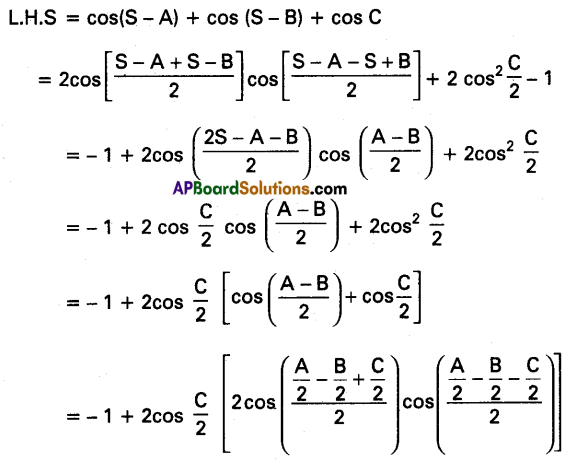
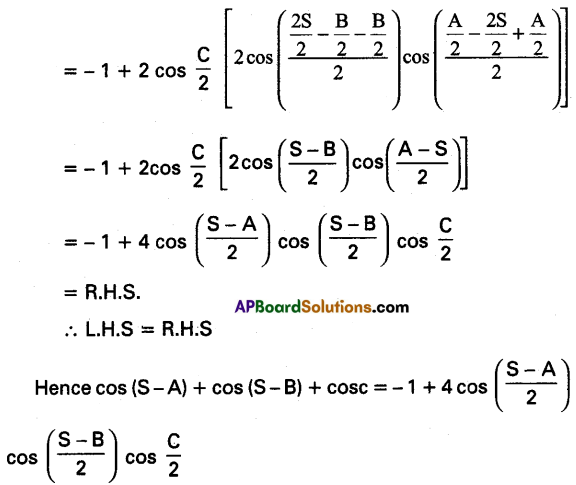
Question 24.
Show that in a ΔABC, \(\frac{1}{r^2}+\frac{1}{r_1^2}+\frac{1}{r_2^2}+\frac{1}{r_3^2}=\frac{a^2+b^2+c^2}{\Delta^2}\).
Solution:
